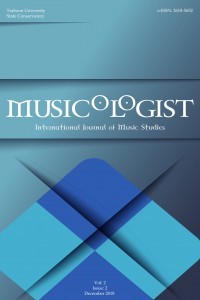Flamenco: Musical Structure and the Practice of Improvisation
Flamenco: Musical Structure and the Practice of Improvisation
flamenco, improvisation, tradition, transmission guitar,
___
- Hecht, Paul. (1968). The Wind Cried ; An American’s Discovery of the World of Flamenco. New York: Dial Press.
- Nettl, Bruno. (2005). The Study of Ethnomusicology: Thirty-one Issues and Concepts (New ed). Urbana: University of Illinois Press. [Original work published 1983]
- Ong, Walter. J., & Hartley, John. (2012). Orality and Literacy: The Technologizing of the Word (3rd ed). London; New York: Routledge. [Original work published 1982]
- Rice, Timothy. (2014). Ethnomusicology: A Very Short Introduction. Oxford: Oxford University Press.
- Yayın Aralığı: Yılda 2 Sayı
- Başlangıç: 2017
- Yayıncı: Trabzon Üniversitesi
A Distinctive Album in Turkey: Bülent Ortaçgil’s Benimle Oynar Mısın
In Defence of the Term and Concept of Traditional Music
Svan Funeral Dirges (Zär): Language-Music Relation and Phonetic Properties
Frank SCHERBAUM, Nana MZHAVANADZE
Flamenco: Musical Structure and the Practice of Improvisation
Towards a Response-Able Electroacoustic Composition Practice: In Search of Sympoietic Multivalence
